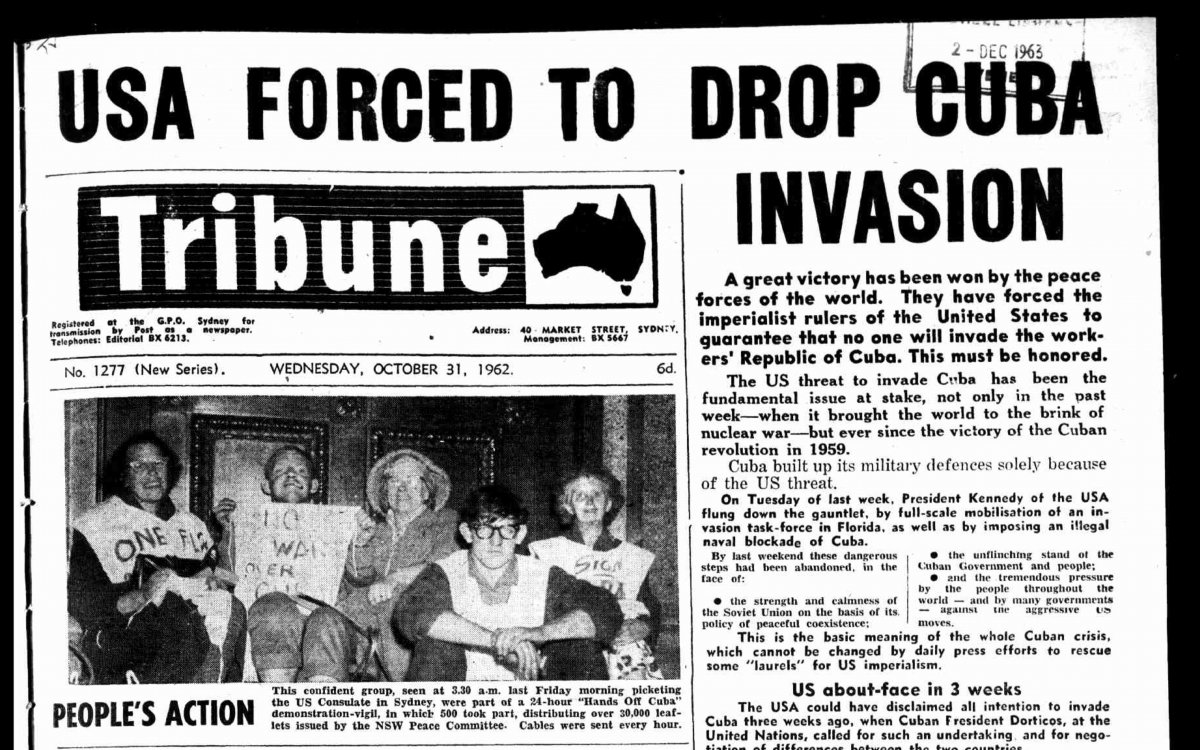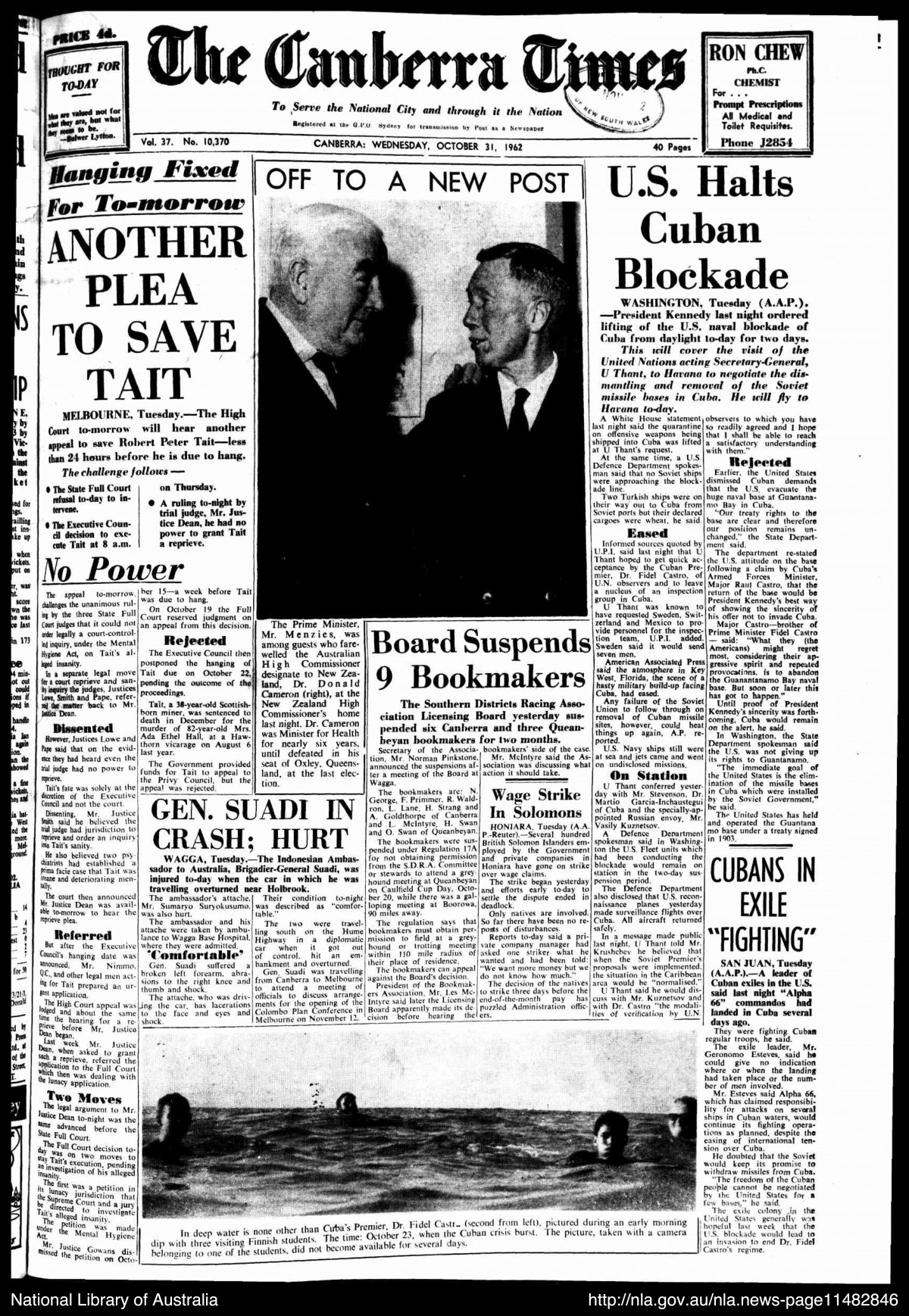Under legal deposit provisions of the Copyright Act (1968), one copy of everything that is published in Australia must be lodged with the National Library of Australia. As a result, the Library’s collection holds a vast array of Australia’s printed news media. Including both physical and digital titles, the Library actively collects approximately 596 contemporary newspaper titles from around the country and selected international publications. The oldest newspaper titles date from the early nineteenth century. As the Library’s mandate is to collect items that tell the Australian story, the titles collected cover a broad range of languages, ideologies, cultures and areas of interest.

(1962, October 31). The Canberra Times (ACT : 1926 - 1995), p. 1, http://nla.gov.au/nla.news-page11482846

(1962, October 31). Tribune (Sydney, NSW : 1939 - 1991), p. 1, http://nla.gov.au/nla.news-page25610837
On 28 October, the Cuban Missile Crisis, a near flashpoint in the Cold War, came to an end after 13 days of anxiety and tense negotiations between US President John F Kennedy and Soviet First Secretary Nikita Khrushchev. To end the crisis, Khrushchev removed missiles from Cuban territory and the US agreed to remove nuclear missiles from Turkey. The stand-off is considered to have brought the world closer to all-out nuclear war than it had or has ever been.
The Cuban Missile Crisis was part of a wider conflict, the Cold War – a war of political ideology between (nominally) the communist Union of Socialist Soviet Republics (USSR) and the United States of America who denounced communism in favour of a free-market system of capitalism. The Australian government sided with the United States and denounced communism; however, this did not mean that the ideology did not exist in Australia at the time.
On 28 October, the Cuban Missile Crisis, a near flashpoint in the Cold War, came to an end after 13 days of anxiety and tense negotiations between US President John F Kennedy and Soviet First Secretary Nikita Khrushchev. To end the crisis, Khrushchev removed missiles from Cuban territory and the US agreed to remove nuclear missiles from Turkey. The stand-off is considered to have brought the world closer to all-out nuclear war than it had or has ever been.
The Cuban Missile Crisis was part of a wider conflict, the Cold War – a war of political ideology between (nominally) the communist Union of Socialist Soviet Republics (USSR) and the United States of America who denounced communism in favour of a free-market system of capitalism. The Australian government sided with the United States and denounced communism; however, this did not mean that the ideology did not exist in Australia at the time.
These two newspapers from Wednesday 31 October, 1962, two days after the end of the Cuban Missile Crisis. One is the newspaper serving the Australian Capital Territory, The Canberra Times, the other is the Tribune. The Tribune was the official newspaper of the Communist Party of Australia and was published from 1939 until 1991.
Both newspapers address the end of the Cuban Missile Crisis, but take a different tone and approach.
Investigate the reporting of this event by these outlets by considering the following:
- Who made this?
- Why was it made?
- When was this made? What else was happening at this time?
- Where does this information come from?
- What’s being left out?
- How could this be interpreted differently by different people?
- What action/reaction does the creator want from me?
- What type of language is being used to convey an ideal, information or perspective?
- What imagery is being used?
- What do we know about the outlets that published these stories?
- Were any other outlets covering this story? What do they say?
- Compare the front pages of both mastheads. What does the way the information is positioned and presented say about the importance of the event? How does the placing of the article impact the way I feel about it?
Below is some more historical information to consider when investigating the reporting of the Cuban Missile Crises by The Canberra Times and the Tribune. These may prove useful prompts when thinking about the motives, perspectives and reliability of the works. Conduct more research into the event to deepen your investigation.
Historical context
- The USSR and its allies and the United States of America and its allies had been embroiled in the Cold War – a conflict of political and economic ideology – since 1945.
- The USSR promoted communism as a viable economic and political system. Communism placed value on the people having shared and equal ownership of property, the means of production and any profits from the sale or exchange of goods. Theoretically, all members of a communist state are equal in pay, social standing and responsibility.
- The United States promoted capitalism as a viable system. In a capitalist system, the production chain and distribution of goods are privately owned and the profits from the sale or exchange of goods and services go to private individuals or companies who are under no obligation to share or distribute said profits.
- The ideals of each system were strongly proclaimed by their respective governments; however, each system had major faults which caused economic, social and political issues.
- Supporters of both communism and capitalism drew on these shortcomings to attack the other form of government, while downplaying the issues within their own system.
- The Tribune was the official newspaper of the Communist Party of Australia and was published by the Central Committee of the Communist Party of Australia.

